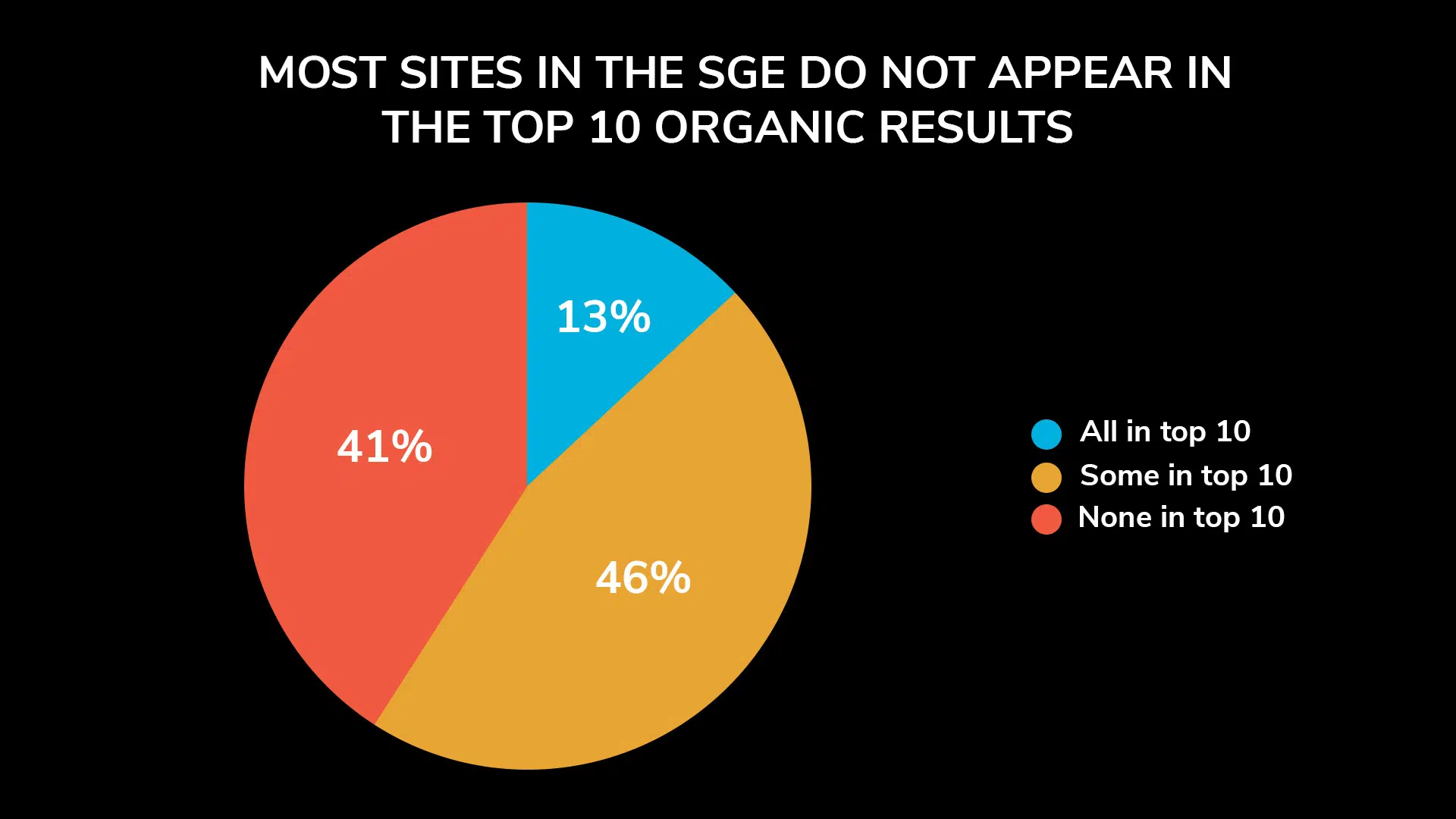As Google evolves with new AI capabilities, SEO strategies must also adapt.
Here’s an overview of key trends and actionable tips to future-proof your presence in search results pages (SERPs).
The evolving SERPs
SERPs today are dominated by rich results, images, videos, social mentions and AI-powered snapshots.
As searchers find answers to their queries directly within the search results, zero-click results continue to rise. This trend is expected to increase with further integration of Search Generative Experience (SGE) in main SERPs as it pulls content from diverse sources.
Out of 100 SGE SERPs, 41% showed zero links from the top 10 organic and 46% showed only some links from the top 10 results, per a recent Moz study.
This demonstrates that SGE is pulling in more long-tail content with higher relevancy and lower volume and using AI’s ability to understand the context to serve niche content better.
Topical entity-rich content is becoming a competitive advantage for any brand. Google deprecated FAQ and How To listings within the search results and no longer reports on their visibility in the Search Console.
However, FAQ content still plays a pivotal role in populating SGE content.
The “People Also Ask” (PAA) feature has emerged as the foremost rich result on SERPs, surpassing even the once-dominant featured snippet.
This shift emphasizes the evolving nature of user queries and the increasing importance of addressing specific, long-tailed questions in your content.
As we look ahead, understanding and adapting to these changing SERPs will be crucial to seeing future organic growth.
The goal: Be the SGE result
The full rollout of SGE is expected to have far-reaching implications on how searchers interact with search engines.
SGE places even more emphasis on producing informative responses that are corroborated by reliable sources. You must adapt your strategies and success metrics accordingly.
SERPs will become more and more unique, to the point that no two searches will generate the same response, according to Dixon Jones, CEO of Inlinks.
For a stable presence in search results, improve your product, know your target audience, and ensure your content addresses their needs.
Trend: Shift toward long-tail and mid-tail searches
Traffic from head terms, typically more generic and high search volumes, is expected to decrease more than traffic from highly focused, niche, and long-tail queries that require specialized and in-depth content.
As users seek more precise, tailored information, marketers and content creators must incorporate more targeted, niche content in their strategy.
Trend: Personalized, topical and hyper-local content helps secure rich snippets and SERPs
SGE’s ability to understand the context and provide personalized results is set to usher in the hyper-local and niche content era.
Introducing context windows will result in more personalized results, catering to individual users’ specific needs and preferences.
This change increases the importance of creating relevant and resonant content with specific audience segments, including hyper-local and community-focused content.
Must-have: Factual verification and authoritative sources
Factual verification is necessary when using large language models (LLMs) and generative AI.
The increasing reliance on AI to generate and curate content underscores the importance of ensuring that content is factual and sourced from authoritative and reliable sources.
You must prioritize establishing credibility and demonstrating the accuracy of your information to maintain trust and authority in your field.
Citation and mentions from authoritative sources play a significant role in factual verification. Gather and showcase reviews, and ensure your site has quality links and citations.
Get the daily newsletter search marketers rely on.
6 steps to future-proof your SERPs in 2024
As the digital landscape evolves with technologies like SGE, it is crucial to adapt your SEO and content strategies accordingly.
To get ahead, you must first understand what dominates SGE results and decide the main areas of focus based on that.
Brands need to build a site for user experience, not to win awards, according to Bill Hunt, president of Back Azimuth Consulting.
The future is about owning SERPs real estate vs. ranks through multiple touchpoints.
Focus on these key areas to future-proof your SERPs in 2024.
1. Multichannel approach
Diversifying your content based on your customer touch point is more important than ever.
Leverage multiple content types and formats to enhance engagement, SERPS, and visibility in important strategy. This includes incorporating:
- Interactive elements: Encourage interaction through video and web story consumption and aim to increase pages per visit. Use engaging video content to capture user interest. Tools like VidIQ can help in measuring video keyword effectiveness.
- Images and infographics: Visual elements can significantly enhance the appeal and understandability of your content.
- Visual storytelling formats: Try experimenting with visual storytelling formats to increase engagement and experience.
Brands need to consider their entire digital presence, not just their .com, according to Patrick Reinhart, VP of services and thought leadership at Conductor.
Have you optimized your YouTube channel? Do you have a Wikipedia page? What are you up to on social media?
These different closed environments will show up increasingly as Google evolves and tests new experiences to attract younger generations, so brands must have a presence on all these platforms.
2. Relevant content
Ensure your content is highly relevant to the search query and keep E-E-A-T in mind. Create content that’s worth talking about.
There are a few steps for creating qualitative content, which can lead to solid SERPs.
- Performance audit: Review if your content aligns with business goals and gives you rich snippets. Ensure you incorporate business goals, content performance, and audience journey as part of content strategy.
- Authorship: Highlight the expertise of the content author to add credibility.
- Optimizing chat experience: Anticipate and answer not just your users’ current questions but also those they haven’t even realized they need answers. Predict what they want to know and deliver it.
- Moving from SERPs to CHERPs: Prepare for interactive and visual SERPs and chat experience results page (CHERPs).
- In-depth, expert content: Be the authority on your topic with detailed, long-form content that connects with the right audience – with the right intent, at the right funnel stage.
- Helpful content: Leverage advanced content strategies with tools that offer data intelligence and scoring, creation, and measurement capabilities to produce high-quality, relevant content.
- Topical and entity gaps: Identify and fill gaps in your content, focusing on topical relevance and specific entities.
3. User experience
Optimizing all touchpoints and the entire journey, including all channels, to improve the overall site experience leads to increased conversions.
- Prioritize user experience and pay attention to the technical health of your domain, including indexing, crawling, speed, and interactive elements.
- The faster your site loads, the easier SGE can read your content and create AI-powered snapshots. Continuously test and improve your website’s user experience.
- Focus on security, mobile-friendliness, page speed and Core Web Vitals (CWV).
- Ensure your site is accessible, incorporating UI/UX best practices.
4. Engagement and conversion rate optimization (CRO)
Use tools like VWO or Crazy Egg to test and enhance your website’s engagement and conversion rate. Track conversions through calls, leads, transactions, and form submissions.
5. Deep schema markup for discovery and clarity
Use schema markup to enhance the visibility of your content. Ensure you are going deep while marking your content, including various assets such as images, videos, menus etc.
Jones also recommends continuing to mark up everything with schema. But know that the way engines use that data will vary.
Your “clicks” from search may decrease, but your “sales” from the search may even increase as search engines and SGE take users further down the purchase funnel.
Dig deeper: How to deploy advanced schema at scale
6. Visual optimization
Centralize and manage digital assets efficiently in a digital asset manager (DAM). Avoid having multiple copies and resolutions of the same image for different applications.
Ensure visual content is optimized and entity-focused. Utilize tools like NLP to score and enhance visual content. Regularly update and optimize visual content for better engagement.
Critical metrics to measure SERP performance
With so much changing, how do you measure success?
Anticipate a significant drop in traffic and click-through rates (CTR) with the introduction of SGE.
- As SGE pushes down organic search results on the SERP, traditional website listings will be less visible.
- Searchers will likely find information directly on the SERP, resulting in fewer clicks on individual website links.
- AI-generated responses make tracking and measuring keyword rankings more challenging.
You must adapt and use different KPIs to measure success. Let’s understand a few critical metrics that brands can use to measure the effectiveness of SERPs in 2024.
Visibility KPIs
SGE visibility data is not available in Google Search Console.
With keyword rankings no longer providing reliable data, you need to focus on alternative visibility metrics like share of search, impressions and rich results visibility to determine if your content is visible to searchers.
Visual rank, pixel depth, pixel height, fold depth, and fold opportunities are new metrics that can help measure visual KPIs, per Ray Greiselhuber of Demand Sphere.
Engagement KPIs
With more content in search results, fewer searchers will click links to visit websites. As traffic drops, engaging every visitor to the site will become important for businesses.
You can no longer afford to ignore engagement metrics like bounce rate, session duration, time on site, scrolls and clicks on your page, and average number of pages visited per session.
Conversion KPIs
Although there may be a decrease in general traffic seeking information at the top of the funnel, you can expect more focused and qualified visitors with a stronger intent to convert.
As a result, your conversion rates should improve.
Conversion metrics like calls, driving directions, transactions, form fills, and any other soft- and hard-conversion KPIs you have for the business will become essential success metrics.
Future-proofing SEO for 2024’s dynamic SERPs
With AI-powered advancements like SGE on the horizon, 2024 will likely bring dramatic changes to SERPs and organic search visibility.
By optimizing for engagement, conversions and overall user experience – rather than traditional keyword rankings alone – you can position your brand to thrive as search evolves.
Opinions expressed in this article are those of the guest author and not necessarily Search Engine Land. Staff authors are listed here.
 We all want to be satisfied, even though we know some people who will never be that way, and others who see satisfaction as a foreign emotion that they can’t hope to ever feel.
We all want to be satisfied, even though we know some people who will never be that way, and others who see satisfaction as a foreign emotion that they can’t hope to ever feel.
Newspaper Ads Canyon Crest CA
Click To See Full Page Ads
Click To See Half Page Ads
Click To See Quarter Page Ads
Click To See Business Card Size Ads
If you have questions before you order, give me a call @ 951-235-3518 or email @ canyoncrestnewspaper@gmail.com
Like us on Facebook Here
What should Google rank in Search when all the content sucks?
Many people have an incredibly low bar for what they consider to be “great” content that...
Google Search Wants To Reward The Best Content No Matter The Size Of The Site
For the past 20 years, probably even longer, the debate about Google giving preferential...















0 Comments